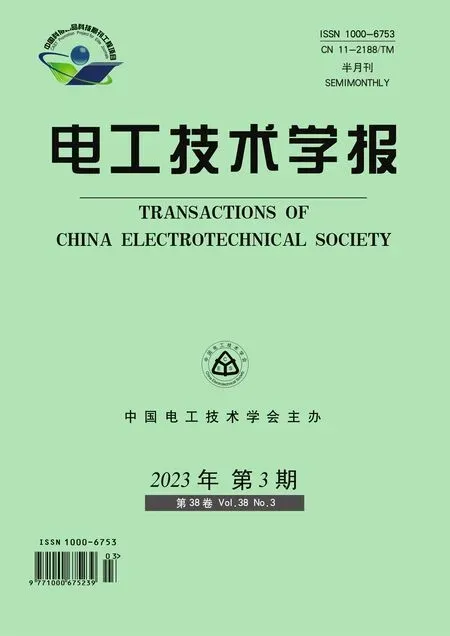考虑多重不确定性的电动汽车聚合商参与能量-调频市场的鲁棒优化模型
徐湘楚 米增强 詹泽伟 纪 陵
考虑多重不确定性的电动汽车聚合商参与能量-调频市场的鲁棒优化模型
徐湘楚1米增强1詹泽伟1纪 陵2
(1. 新能源电力系统国家重点实验室(华北电力大学) 保定 071003 2. 国电南京自动化股份有限公司 南京 210003)
为了充分挖掘电动汽车(EV)参与电力市场交易的市场价值,电动汽车聚合商(EVA)可将众多EV资源聚合起来作为一个投标主体参与日前能量和调频市场。针对EVA参与电力市场的投标决策面临多重不确定性因素影响问题,计及EV电量和功率边界,建立了EVA响应能力评估模型;对EV用户响应意愿、调频信号和市场电价的不确定性进行建模;以EVA的投标净收益最大化为目标,构建一种考虑多重不确定性的EVA参与能量-调频市场的鲁棒优化模型,以合理制定次日各交易时段EVA的基线功率和所提供的调频容量。通过算例验证了模型的有效性,并分析了各种不确定因素对投标净收益的影响,所提策略可为EVA的投标决策提供参考。
电动汽车聚合商 能量-调频市场 多重不确定性 鲁棒优化
0 引言
构建以新能源为主体的新型电力系统是实现“碳达峰、碳中和”目标的主要战略举措之一,但随着新能源的大规模接入,其随机性、波动性给电力系统安全稳定运行带来了巨大挑战。传统的以“源随荷动”来实现系统供需平衡的调控模式已难以为继,利用柔性负荷资源的需求响应方案为破解系统供需平衡难题提供了新的解决思路[1]。
电动汽车(Electric Vehicle, EV)作为一种重要的需求响应资源,因其节能减排的优势,近年来发展迅猛。根据国际能源署公布的《Global EV Outlook 2021》报告显示,2020年全球EV的数量已经达到约1 000万辆,预计到2030年将飙升至1.45亿辆[2]。此外,随着5G通信、智能控制技术和大数据分析技术的发展,以及电力市场机制的完善,使得聚合碎片化的EV资源并高效利用在电力辅助服务市场成为可能[3]。电动汽车聚合商(Electric Vehicle Aggregator, EVA)作为电力市场和EV用户之间的中间代理机构,可将众多EV聚合成一个利益主体参与电力市场交易,为电力系统提供多种辅助服务,如削峰填谷、旋转备用、调频、促进新能源消纳等[4-7]。
然而电力市场和EV用户具有的不确定性会给EVA的投标决策带来一定挑战。其中与电力市场相关的不确定性因素包括能量电价、辅助服务价格、调频信号等;EV用户的不确定性因素有EV入网/离网时间、入网/离网时的荷电状态(State of Charge, SOC)、用户响应意愿等。在已有的研究文献中,对不确定性问题的处理方法大致可分为随机优化、模糊优化和鲁棒优化三种[8]。其中随机优化和模糊优化方法需要利用相应的概率分布函数和隶属度函数来表征变量的不确定性,而鲁棒优化方法只需定义变量的置信区间,对于无法获得相关变量概率分布函数和隶属度函数的场景,鲁棒优化方法具有更好的适用性。
基于随机优化或模糊优化方法,文献[9]提出了一种EVA参与日前和实时能量市场与调频市场的最佳投标策略,所提方案基于两阶段随机规划方法,通过条件风险价值法来规避风险,包括将电价、调频信号及与EV车主相关的不确定性建模为由不同场景集表示的随机过程。文献[10]建立了以最大化EVA预期利润为目标的随机优化模型,从而制定EVA参与日前能量市场的最优投标策略,基于历史数据利用随机优化方法对市场出清场景和不同类型EV充电模式的不确定性进行建模。文献[11]在考虑了备用需求的不确定性的情况下,提出一种EVA参与能量市场和备用市场的随机优化模型。文献[12]基于数据驱动方法,提出EVA参与能量市场和备用市场的随机优化模型,考虑了EV充电行为和调频信号的不确定性。文献[13]利用随机规划方法制定了EVA参与能量市场和调节市场的最优投标策略,考虑了市场电价和调节信号的不确定性。尽管上述文献确定了最大化EVA预期利润的策略,但不能保证完全防止出现不确定性的最坏情况,如果不确定性场景没有正确生成,则可能无法得到正确的优化结果。文献[14]提出了一种EVA参与多个辅助服务市场的协调优化投标策略,使用模糊优化考虑辅助服务价格和调节信号的不确定性。文献[15]考虑了能量市场电价和EV移动性相关的不确定性,提出一种模糊优化模型,旨在最大化停车场运营商(等价于EVA)的利润,同时满足EV车主的充电需求。然而,模糊规划的难点在于构建合理的隶属度函数。
相比于随机优化和模糊优化方法,基于鲁棒优化的EVA的决策模型计算成本较低,并且可以在最坏的不确定性场景下给出使得EVA自身利益最大化的优化投标策略。然而,这方面的研究文献较少。文献[16]提出一种考虑价格不确定性的鲁棒优化模型,旨在制定可供电力零售商使用的各种决策策略。文献[17]提出一种EVA参与日前能量市场的分层优化决策模型,旨在使其自身利益最大化,利用鲁棒优化方法考虑了EV出行模式的不确定性,同时考虑了电池退化成本对收益的影响,但是没有考虑电价的不确定性。文献[18]提出一种EVA参与能量市场的鲁棒优化方法,考虑了电价不确定性对EVA优化调度的影响。文献[19]提出非合作博弈和合作博弈两种鲁棒优化策略,其中不确定性集用于刻画EV集群的总能量需求。文献[20]提出一种EV集群并网的分布式鲁棒优化调度模型。文献[21]提出一种考虑EV电池退化成本的EV集群调度算法,所提方案中利用鲁棒优化表征了电价的不确定性。文献[22]建立了EVA参与日前能量市场的随机鲁棒优化投标模型,其中日前市场价格和EV出行需求的不确定性分别使用场景法和置信区间进行建模。但是,以上鲁棒优化模型只考虑了EVA仅参加能量市场的场景,忽略了EV参与辅助服务市场的价值。文献[23]提出了集中充电站同时参与能量市场和调频市场的鲁棒优化模型,考虑了能量电价和调频电价的不确定性。然而,文献[16-23]的鲁棒优化模型中均未考虑EV用户响应意愿不确定性的影响。
针对上述文献研究的不足,为了充分挖掘EV的市场价值,特别是EV因具有快速调节特性,是一种稀缺的优质调频资源,本文提出一种EVA参与日前能量市场和调频辅助市场的投标决策模型。利用鲁棒优化方法全面地考虑了包括EV用户响应意愿、调频信号和市场电价(能量电价,调频电价)等在内的多重不确定性因素,通过算例分析了EVA在日前电力市场的投标策略和投标净收益。
1 EVA参与能量-调频市场框架
EVA作为电力市场和EV用户之间的中间代理机构,其参与能量-调频市场的框架如图1所示。EVA的主要职责可相应地分为两部分:①采集EV的出行特征参数、电池参数、运行状态及用户用电期望等信息,为EV用户提出合理的激励和补偿方案,对具有响应意愿的EV集群聚合响应能力进行评估,并根据下发的调度目标指令直接控制各EV的充放电行为;②在投标过程中与不同电力市场的交易,如能量市场、备用市场和调频市场等,为电力系统提供各种不同的辅助服务。

图1 EVA参与能量-调频市场框架
2 EVA响应能力评估模型
2.1 EV单体模型





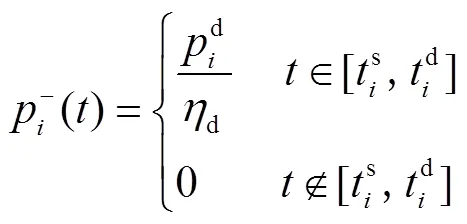
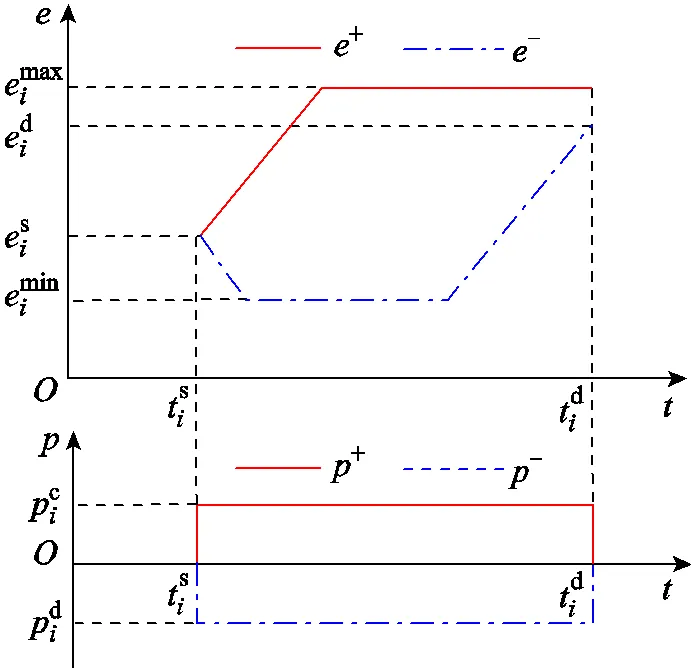
图2 EV单体的电量和功率边界
2.2 EVA模型
EVA可聚合和控制某一区域范围内大规模的EV,可利用所有EV的电量和功率边界的总和来表示EVA的总电量和功率边界。EVA的电量和功率边界为
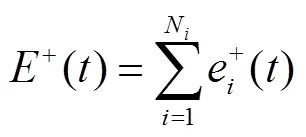

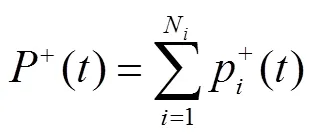

2.3 EVA的响应能力边界



3 不确定性因素建模
3.1 EV用户的响应意愿
实际中EV用户由于出行习惯、对激励水平的敏感程度等因素造成响应行为的不确定性,计及不确定性后EV用户的响应意愿示意图如图3所示。图中黑色实线为基于消费者心理学原理的EV用户响应意愿曲线,随着激励价格的变化可分为死区、线性区和饱和区,红色虚线为EV响应意愿的最大波动曲线。
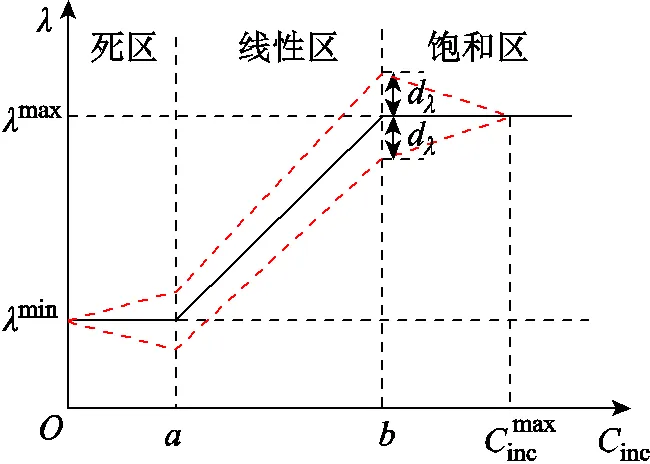
图3 EV用户响应意愿不确定性示意图
从图3可以看出,在死区和线性区,当激励水平还不够高时,响应不确定性主要取决于非经济因素,EV用户响应意愿随着激励价格的增大而增大,同时响应不确定性也随之增加。在饱和区,激励水平对用户有足够吸引力,此时响应不确定性主要由经济因素决定,随着激励水平的提高,响应意愿已达上限,但响应不确定性逐渐减小到零[25]。
EV用户响应意愿和响应偏差为
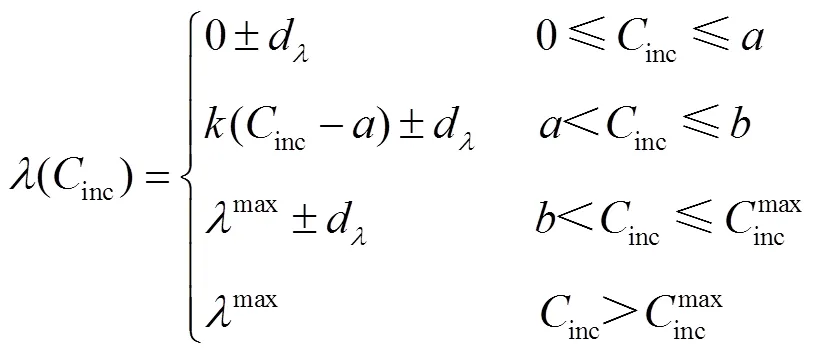

3.2 调频信号

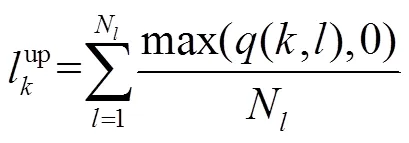

3.3 市场电价
本文中市场电价包括EVA参与能量市场的能量电价及EVA参与调频市场的上调频和下调频电价。由于出清场景的不确定性,市场电价不是确定值,而是在预测电价上下一定范围内波动,其不确定性可用鲁棒优化方法处理。
4 EVA投标决策模型
电力市场机制对EVA的投标决策具有显著影响,本文研究工作的市场机制基础如下:①参与调频辅助服务的容量补偿按上调频容量和下调频容量分开结算;②因参与调频辅助服务的造成的充电功率与基线功率的偏差,按照能量价格进行结算;③EVA所需的基线功率和提供的调频容量不足以影响区域电力市场的出清价格,即EVA被当作市场价格接受者。
4.1 确定性优化模型
EVA参与日前能量市场和调频市场的确定性优化模型如下,以最大化EVA净收益为优化目标,目标函数为



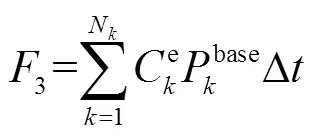



模型需满足的约束条件为



约束式(1)~式(12),式(15)~式(17)(27)
式(24)~式(26)为EVA运行功率和调频容量不越限的约束条件。
4.2 鲁棒优化模型
全面考虑EV用户响应意愿、调频信号和市场电价的不确定性,通过鲁棒对等转换将确定性优化模型转变为鲁棒优化模型,构建的EVA参与能量-调频市场的鲁棒优化投标决策模型可描述为

























约束式(1)~式(10)(54)
目标函数(28)和约束条件(29)考虑了不确定性对EVA净收益的影响;式(30)~式(33)表示考虑EV用户响应意愿的EVA电量和功率的上、下边界;式(34)和式(35)表示考虑EV用户响应意愿的EVA的响应能力上、下边界;式(36)和式(37)表示考虑调频信号不确定性后EVA运行时电量不越限的约束条件;式(38)~式(40)为EVA充电功率和调频容量不越限的约束条件;式(41)~式(53)为鲁棒优化约束条件。
5 算例分析
5.1 参数设置


图4 预测电价
表1 主要参数
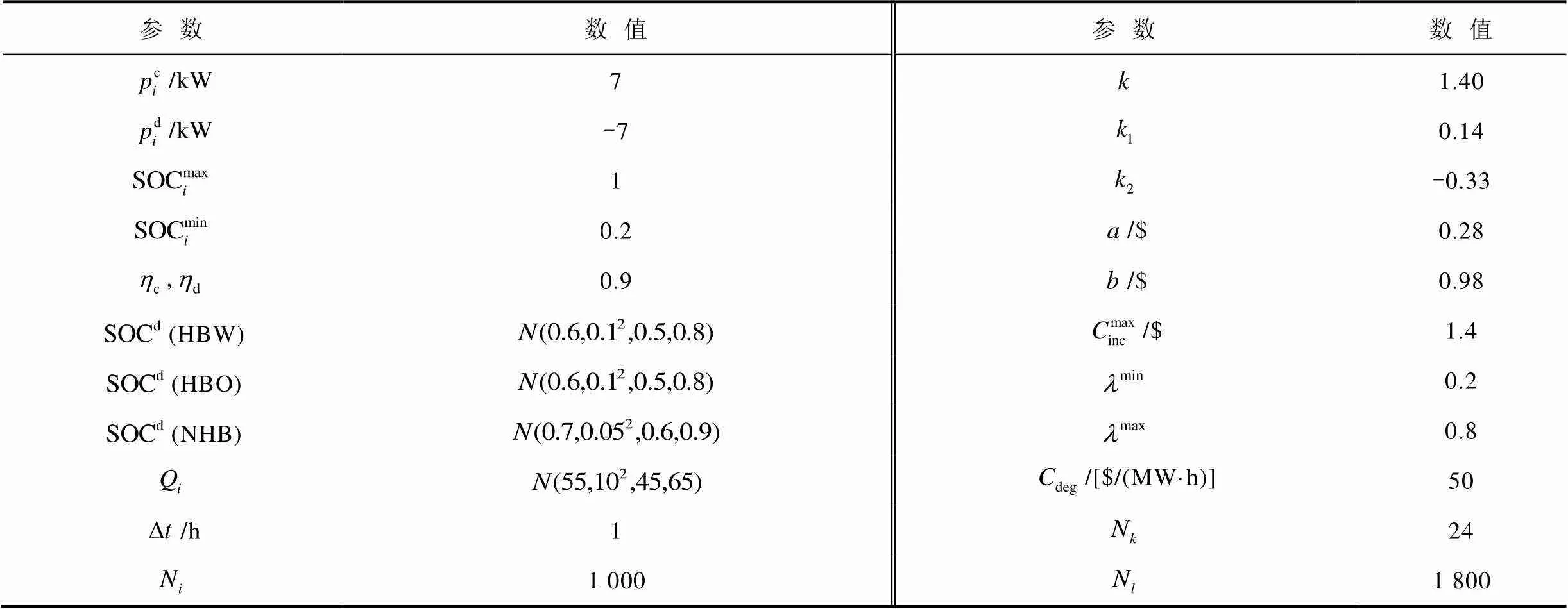
Tab.1 Main parameters
本文采用Python 3.7+Gurobi 9.5求解器软件环境对鲁棒优化问题进行求解,系统硬件环境为Intel Core I7 CPU,3.4GHz,16GB内存。
5.2 确定性优化调度策略分析
EV因具有快速调节特性,是一种稀缺的优质调频资源,为充分体现EVA参与电力市场的市场价值,设置了两种场景进行对比分析。场景一:EVA只参与能量市场;场景二:EVA参与能量市场和调频市场。为了显示方便,本文所有图中上调频容量显示为负。

图5 时EVA的调度策略
不同场景下EVA的SOC变化曲线如图6所示。从图6可以看出,场景二下EVA的SOC相比于场景一波动范围更小,数值更集中于中间区域。这是因为当EVA同时参与能量市场和调频市场时,EVA会预留一部分容量响应系统调频需求,同时获得更高的收益,因此,EVA会避免过充或过放。

图6 不同场景下EVA的SOC变化曲线
EVA在两种场景下的收益对比见表2,在场景一下EVA只能通过电价差套利,当电价差不够大或者支付给EV的补偿成本较高时,EVA的净利润可能为负。在场景二下,EVA的主要收益来自提供调频服务,扣除额外电池损耗和EV补偿成本外,仍具有可观净收益。
表2 收益对比分析

Tab.2 Revenue comparative analysis (单位:$)
5.3 鲁棒优化调度策略分析
5.3.1 激励水平对调度策略的影响
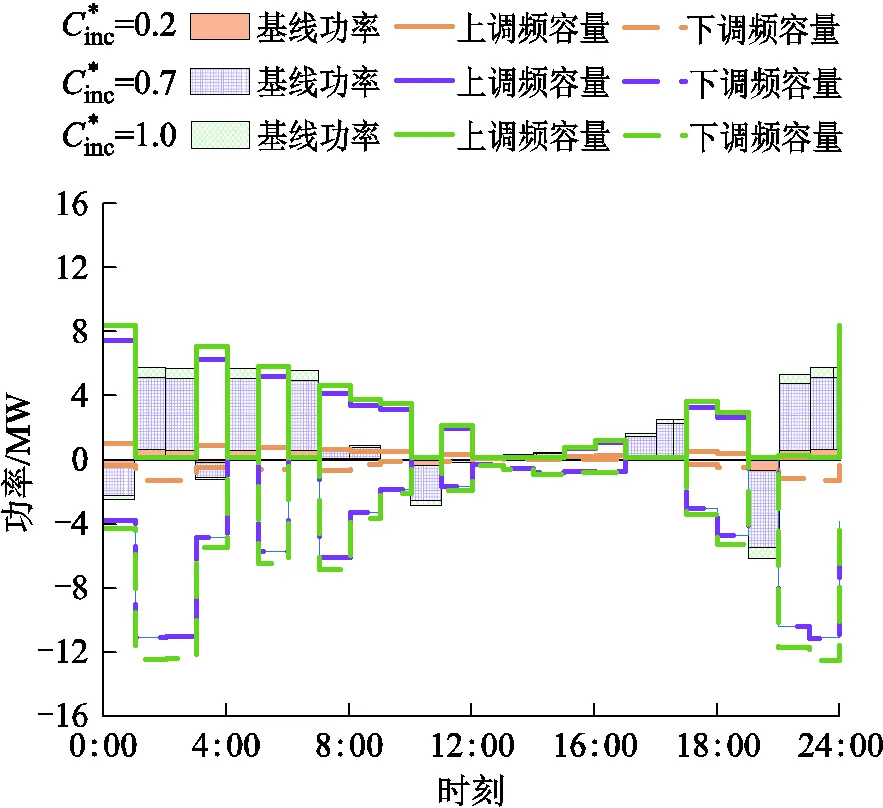
图7 时不同激励水平下EVA的调度策略
5.3.2 鲁棒控制系数对调度策略的影响
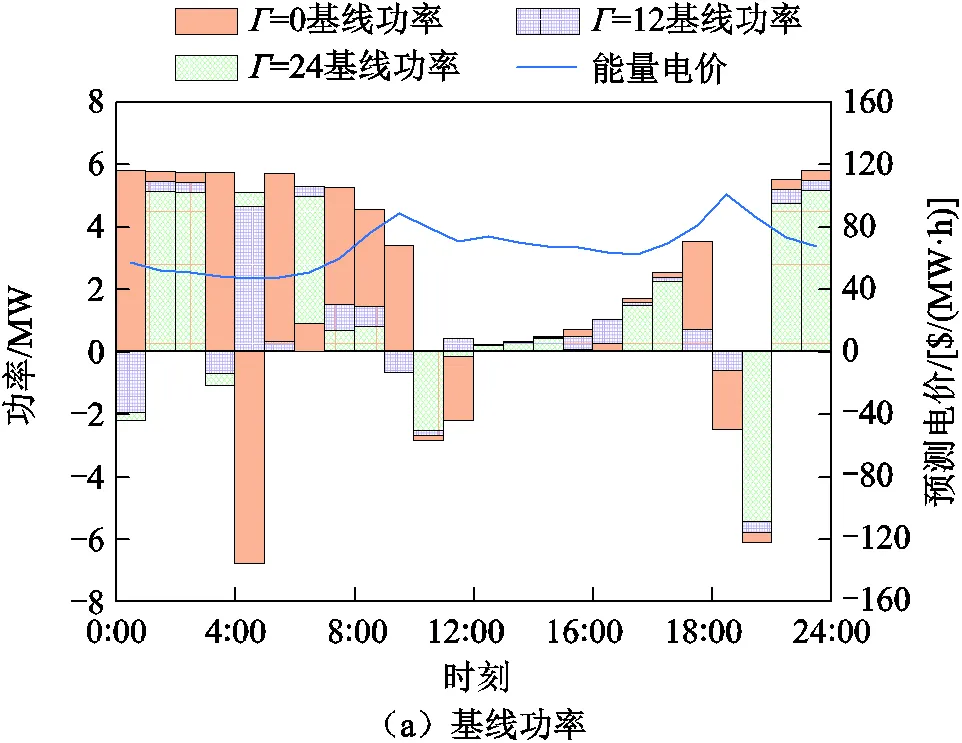
5.4 投标收益分析
为了分析激励水平与鲁棒控制系数对EVA投标收益的影响,设置了以下几种方案进行对比分析。方案一:不考虑不确定因素的影响,等价于确定性优化;方案二:只考虑调频电价的鲁棒性;方案三:只考虑能量电价的鲁棒性;方案四:只考虑EV响应意愿的鲁棒性;方案五:只考虑调频信号的鲁棒性;方案六(本文所提方案):全面考虑EV响应意愿、调频信号和市场电价的鲁棒性。
不同方案下EVA的投标收益如图9所示,具体净收益数值见表3。由图9可知,相同条件下,考虑不确定性的鲁棒优化投标策略相对于确定性投标策略更加保守,因此收益更小,但不确定性因素对投标收益的影响却不尽相同。由表3可知,EVA的收益基本上为正值,说明EVA同时参与能量和调频辅助服务市场,通过能量电价差套利和提供调频辅助服务获利,这有助于提高EVA参与电力市场的积极性。

图9 不同方案下EVA的投标净收益
表3 EVA投标净收益

Tab.3 EVA's net bidding revenue (单位:$)
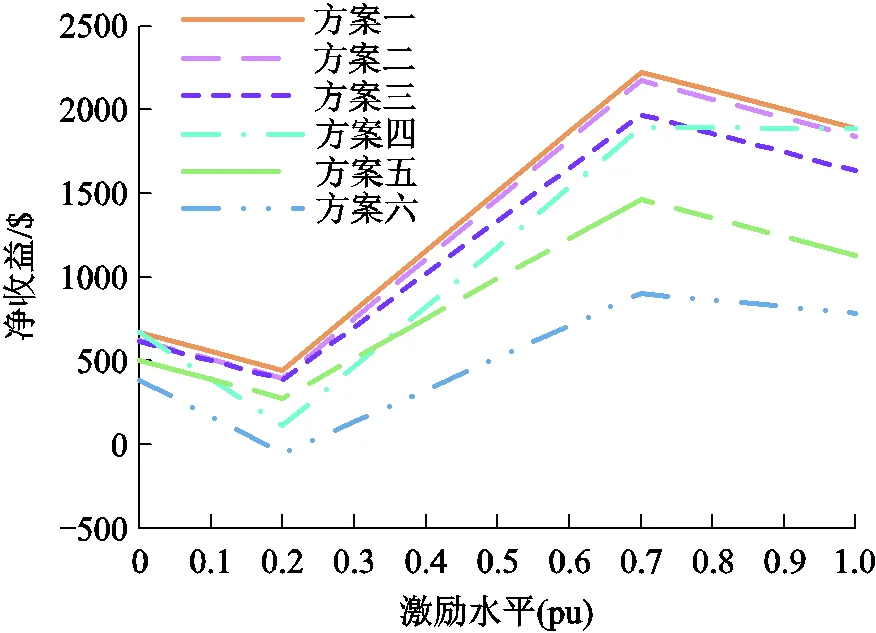
图10 时激励水平对投标净收益的影响
图11 时鲁棒控制系数对投标净收益的影响
Fig.11 The influence of robust control factor on net bidding revenue when
另外,市场电价的预测误差区间也会对鲁棒优化结果产生影响。假设能量电价和调频电价的预测值与实际值的误差均在0~30%内,分别取预测误差为0、5%、10%、15%、20%、25%、30%。在不同市场电价预测误差下EVA的鲁棒净收益如图12所示。随着市场电价预测误差的增大,EVA的鲁棒净收益逐渐减小。当能量电价和调频电价的误差为0 时,净收益为2 050.5$;当能量电价和调频电价的误差为30%时,净收益为1 579.1$。

图12 电价预测误差对投标净收益的影响
6 结论
在电力市场环境下,为了充分挖掘EV作为优质调频资源的市场价值,同时考虑到EVA投标决策面临各种不确定因素的影响,本文提出一种EVA同时参与日前能量市场和调频辅助市场的投标决策鲁棒优化模型。主要结论如下:
1)EVA主要通过参与调频市场获利,因EV的优质调频特性,为充分体现EVA的市场价值,EVA更适宜参与调频市场。
2)提高激励水平可以提高EV用户的响应意愿,进而增大EVA的响应能力,在一定程度上可以提高EVA的投标收益。但是一味增大激励水平,可能使得EV的调度成本显著增加,EVA的净收益反而减小。因此,EVA应该根据调频需求设置合理的激励水平。
3)增大鲁棒控制系数可降低EVA的投标风险,但投标净收益也随之减小,不同不确定性因素的鲁棒性对EVA净收益的影响的重要程度不同,其中调频信号的不确定性对EVA投标净收益的影响最大。
4)本文所提模型全面考虑了EVA参与能量-调频市场联合优化投标决策所面临的各种不确定性因素的影响,优化结果可为EVA的投标决策提供可靠参考。
后续研究将进一步关注如何将EVA调度指令合理分解到每辆EV,聚焦实时控制策略研究和补偿机制设计。
[1] 王锡凡, 邵成成, 王秀丽, 等. 电动汽车充电负荷与调度控制策略综述[J]. 中国电机工程学报, 2013, 33(1): 1-10.
Wang Xifan, Shao Chengcheng, Wang Xiuli, et al. Survey of electric vehicle charging load and dispatch control strategies[J]. Proceedings of the CSEE, 2013, 33(1): 1-10.
[2] International Energy Agency Website. Global EV Outlook 2021. [R/OL]. 2021. https://www.iea.org/ reports/global-ev-outlook-2021.
[3] 贾雨龙, 米增强, 余洋, 等. 计及不确定性的柔性负荷聚合商随机-鲁棒投标决策模型[J]. 电工技术学报, 2019, 34(19): 4096-4107.
Jia Yulong, Mi Zengqiang, Yu Yang, et al. Stochastic-robust decision-making model for flexible load aggregator considering uncertainties[J]. Transactions of China Electrotechnical Society, 2019, 34(19): 4096-4107.
[4] 张谦, 邓小松, 岳焕展, 等. 计及电池寿命损耗的电动汽车参与能量-调频市场协同优化策略[J]. 电工技术学报, 2022, 37(1): 72-81.
Zhang Qian, Deng Xiaosong, Yue Huanzhan, et al. Coordinated optimization strategy of electric vehicle cluster participating in energy and frequency regulation markets considering battery lifetime degradation[J]. Transactions of China Electrotechnical Society, 2022, 37(1): 72-81.
[5] 吴巨爱, 薛禹胜, 谢东亮, 等. 电动汽车参与电量市场与备用市场的联合风险调度[J]. 电工技术学报, 2022, DOI: 10.19595/j.cnki.1000-6753.tces. 221386.
Wu Juai, Xue Yusheng, Xie Dongliang, et al. The joint risk dispatch of electric vehicle in day-ahead electricity energy market and reserve market[J]. Transactions of China Electrotechnical Society, 2022. DOI: 10.19595/j.cnki.1000-6753.tces.221386.
[6] 胡俊杰, 马文帅, 薛禹胜, 等. 基于CPSSE框架的电动汽车聚合商备用容量量化[J]. 电力系统自动化, 2022, 46(18): 46-54.
Hu Junjie, Ma Wenshuai, Xue Yusheng, et al. Quantification of reserve capacity provided by electric vehicle aggregator based on framework of cyber-physical-social system in energy[J]. Automation of Electric Power Systems, 2022, 46(18): 46-54.
[7] 娄素华, 张立静, 吴耀武, 等. 低碳经济下电动汽车集群与电力系统间的协调优化运行[J]. 电工技术学报, 2017, 32(5): 176-183.
Lou Suhua, Zhang Lijing, Wu Yaowu, et al. Coordination operation of electric vehicles and power system under low-carbon economy[J]. Transactions of China Electrotechnical Society, 2017, 32(5): 176-183.
[8] Lu Xiaoxing, Li Kangping, Wang Fei, et al. Optimal bidding strategy of DER aggregator considering bilateral uncertainty via information gap decision theory[J]. IEEE Transactions on Industry Applications, 2021, 57(1): 158-169.
[9] Habibifar R, Aris Lekvan A, Ehsan M. A risk-constrained decision support tool for EV aggregators participating in energy and frequency regulation markets[J]. Electric Power Systems Research, 2020, 185: 106367.
[10] Zheng Yanchong, Yu Hang, Shao Ziyun, et al. Day-ahead bidding strategy for electric vehicle aggregator enabling multiple agent modes in uncertain electricity markets[J]. Applied Energy, 2020, 280: 115977.
[11] Han Bing, Lu Shaofeng, Xue Fei, et al. Day-ahead electric vehicle aggregator bidding strategy using stochastic programming in an uncertain reserve market[J]. IET Generation, Transmission & Distribution, 2019, 13(12): 2517-2525.
[12] Wu Zhouyang, Hu Junjie, Ai Xin, et al. Data-driven approaches for optimizing EV aggregator power profile in energy and reserve market[J]. International Journal of Electrical Power & Energy Systems, 2021, 129: 106808.
[13] Vagropoulos S I, Bakirtzis A G. Optimal bidding strategy for electric vehicle aggregators in electricity markets[J]. IEEE Transactions on Power Systems, 2013, 28(4): 4031-4041.
[14] Ansari M, Al-Awami A T, Sortomme E, et al. Coordinated bidding of ancillary services for vehicle-to-grid using fuzzy optimization[J]. IEEE Transactions on Smart Grid, 2015, 6(1): 261-270.
[15] Faddel S, Al-Awami A T, Abido M A. Fuzzy optimization for the operation of electric vehicle parking lots[J]. Electric Power Systems Research, 2017, 145: 166-174.
[16] Nojavan S, Mohammadi-Ivatloo B, Zare K. Optimal bidding strategy of electricity retailers using robust optimisation approach considering time-of-use rate demand response programs under market price uncertainties[J]. IET Generation, Transmission & Distribution, 2015, 9(4): 328-338.
[17] Porras Á, Fernández-Blanco R, Morales J M, et al. An efficient robust approach to the day-ahead operation of an aggregator of electric vehicles[J]. IEEE Transactions on Smart Grid, 2020, 11(6): 4960-4970.
[18] Cao Yan, Huang Liang, Li Yiqing, et al. Optimal scheduling of electric vehicles aggregator under market price uncertainty using robust optimization technique[J]. International Journal of Electrical Power & Energy Systems, 2020, 117: 105628.
[19] Yang Helin, Xie Xianzhong, Vasilakos A V. Noncooperative and cooperative optimization of electric vehicle charging under demand uncertainty: a robust stackelberg game[J]. IEEE Transactions on Vehicular Technology, 2016, 65(3): 1043-1058.
[20] 许刚, 张丙旭, 张广超. 电动汽车集群并网的分布式鲁棒优化调度模型[J]. 电工技术学报, 2021, 36(3): 565-578.
Xu Gang, Zhang Bingxu, Zhang Guangchao. Distributed and robust optimal scheduling model for large-scale electric vehicles connected to grid[J]. Transactions of China Electrotechnical Society, 2021, 36(3): 565-578.
[21] Ortega-Vazquez M A. Optimal scheduling of electric vehicle charging and vehicle-to-grid services at household level including battery degradation and price uncertainty[J]. IET Generation, Transmission & Distribution, 2014, 8(6): 1007-1016.
[22] Baringo L, Sánchez Amaro R. A stochastic robust optimization approach for the bidding strategy of an electric vehicle aggregator[J]. Electric Power Systems Research, 2017, 146: 362-370.
[23] 姚伟锋, 赵俊华, 文福拴, 等. 集中充电模式下的电动汽车调频策略[J]. 电力系统自动化, 2014, 38(9): 69-76.
Yao Weifeng, Zhao Junhua, Wen Fushuan, et al. Frequency regulation strategy for electric vehicles with centralized charging[J]. Automation of Electric Power Systems, 2014, 38(9): 69-76.
[24] Zhang Hongcai, Hu Zechun, Xu Zhiwei, et al. Evaluation of achievable vehicle-to-grid capacity using aggregate PEV model[J]. IEEE Transactions on Power Systems, 2017, 32(1): 784-794.
[25] 赵冬梅, 宋原, 王云龙, 等. 考虑柔性负荷响应不确定性的多时间尺度协调调度模型[J]. 电力系统自动化, 2019, 43(22): 21-30.
Zhao Dongmei, Song Yuan, Wang Yunlong, et al. Coordinated scheduling model with multiple time scales considering response uncertainty of flexible load[J]. Automation of Electric Power Systems, 2019, 43(22): 21-30.
[26] 张亚朋, 穆云飞, 贾宏杰, 等. 电动汽车虚拟电厂的多时间尺度响应能力评估模型[J]. 电力系统自动化, 2019, 43(12): 94-103.
Zhang Yapeng, Mu Yunfei, Jia Hongjie, et al. Response capability evaluation model with multiple time scales for electric vehicle virtual power plant[J]. Automation of Electric Power Systems, 2019, 43(12): 94-103.
[27] Mu Yunfei, Wu Jianzhong, Jenkins N, et al. A spatial-temporal model for grid impact analysis of plug-in electric vehicles[J]. Applied Energy, 2014, 114: 456-465.
[28] PJM Data Website. PJM Data Miner2[DB/OL]. 2021. https://dataminer2. pjm.com /list.
A Robust Optimization Model for Electric Vehicle Aggregator Participation in Energy and Frequency Regulation Markets Considering Multiple Uncertainties
Xu Xiangchu1Mi Zengqiang1Zhan Zewei1Ji Ling2
(1. State Key Laboratory of Alternate Electrical Power System with Renewable Energy Sources North China Electric Power University Baoding 071003 China 2. Guodian Nanjing Automation Co. Ltd Nanjing 210003 China)
In order to fully exploit the market value of electric vehicle (EV) participation in the electricity market, EV aggregator (EVA) can aggregate large number of EV resources to participate in the day-ahead energy and frequency regulation markets as a bidding entity. To address the problem that EVA face multiple uncertainties in bidding decisions to participate in the electricity market, a response capability evaluation model of EVA is developed, the uncertainty characteristics of EV users' willingness to respond, frequency regulation signals and market electricity prices are modeled, and a robust optimization model for EVA participation in the energy and frequency regulation markets considering multiple uncertainties is constructed.
Firstly, the energy and power boundaries of an individual EV are evaluated, and the energy and power boundaries of the EVA are obtained by aggregation, based on which the response capability evaluation model of the EVA is constructed. Furthermore, the uncertainties facing by EVA participation in the energy and frequency regulation markets are modeled. Among them, EV users' willingness to respond is characterized based on consumer psychology principles, and EVA energy accumulation triggered by frequency regulation signals is portrayed by frequency regulation energy coefficients. Uncertainties including EV users' willingness to respond, frequency regulation signals and market electricity prices can be handled by robust optimization methods. Finally, A robust optimization model for EVA participation in the energy and frequency regulation markets considering multiple uncertainties is constructed with the objective of maximizing the net bidding revenue of EVA.
The bidding strategies of EVA in the day-ahead electricity market under several scenarios are constructed and their net bidding revenues are compared. The case simulation results show that the proposed robust optimization model can reasonably formulate the dispatching strategy for EVA to participate in the day-ahead energy and frequency regulation markets.
Based on the case simulation results, the main conclusions can be obtained as follows. ① EVA mainly profits by participating in the frequency regulation market, and it is more appropriate for EVA to participate in the frequency regulation market in order to fully reflect the market value of EVA. ② Increasing the incentive level can increase the response willingness of EV users, which in turn increases the response capability of EVA, and to a certain extent can improve the bidding revenue of EVA. However, increasing the incentive level may make the dispatching cost of EVs increase significantly, and the net revenue of EVA decreases instead. Therefore, EVA should set a reasonable incentive level according to the frequency regulation demand. ③ Increasing the robust control coefficient can reduce the bidding risk of EVA, but the net bidding revenue also decreases. The robustness of different uncertainty factors has different degrees of importance on the net bidding revenue of EVA, among which the uncertainty of frequency regulation signal has the greatest impact on the net bidding revenue of EVA. ④ The model proposed comprehensively considers the impact of various uncertainties faced by EVA in the energy and frequency regulation markets joint optimization bidding decision, and the optimization results can provide a reliable reference for EVA's bidding decision.
Electric vehicle aggregator, energy and frequency regulation markets, multiple uncertainties, robust optimization
10.19595/j.cnki.1000-6753.tces.220597
TM732
国家重点研发计划项目(2018YFE0122200)和中国华电集团“揭榜挂帅”项目(CHDKJ21-01-107)资助。
2022-04-18
2022-11-11
徐湘楚 男,1990年生,博士研究生,研究方向为电动汽车聚合建模及响应能力评估、柔性负荷聚合调控技术和电力市场等。E-mail:xxc@ncepu.edu.cn(通信作者)
米增强 男,1960年生,教授,博士生导师,研究方向为新能源发电功率预测、柔性负荷聚合调控技术等。E-mail:mizengqiang@sina.com
(编辑 赫蕾)

